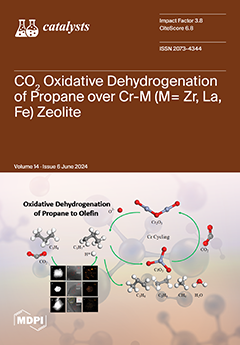CO
2 oxidative dehydrogenation of propane (CO
2-ODHP), being not only favorable for olefin production but also beneficial for CO
2 emission control, has recently attracted great attention. Here, a series of single metal (Cr) and bimetal (Zr, La, Fe) modified ZSM-5 zeolites were prepared via an impregnation method. It was found that the bimetal modified ZSM-5 possessed much higher C
3H
8 and CO
2 conversion than that of monometallic modified Cr
3%-ZSM-5 (Cr
3%-Z5), especially for Cr
3%Zr
2%-ZSM-5 (Cr
3%Zr
2%-Z5), which displayed the highest activity (65.4%) and olefin yield (1.65 × 10
3 μmol·
h
−1). Various characterizations were performed, including XRD, N
2 adsorption-desorption, H
2-TPR, Raman, XPS, HAAD-STEM, and TEM. It was revealed that Zr not only favored an improvement in the redox ability of Cr, but also contributed to the surface dispersion of loaded Cr species, constituting two major reasons explaining the superior activity of Cr
3%Zr
2%-Z5. To further improve CO
2-ODHP catalytic behavior, a series of Cr
3%-ZSM-5@SBA-15-n composite zeolite catalysts with diverse (ZSM-5/SBA-15) mass ratios were prepared (Cr
3%-ZS-n, n = 0.5, 2, 6, 16), which screened out an optimum mass ratio of six. Based on this, the Cr
3%Zr
2%-ZS-6 compound was further prepared, and it eventually achieved even higher CO
2-ODHP activity (76.9%) and olefin yield (1.72 × 10
3 μmol·
h
−1). Finally, the CO
2-ODHP reaction mechanism was further investigated using in situ FTIR, and it was found that the reaction followed the Mars–van Krevelen mechanism, wherein CO
2 participated in the reaction through generation of polydentate carbonates. The Cr
6+ constituted as the active site, which was reduced to Cr
3+ after the dihydrogen reaction, and was then further oxidized into Cr
6+ by CO
2, forming polydentate carbonates, and thus cycling the reactive species Cr
6+. Additionally, assisted by a Brönsted acid site (favoring breaking of the C-C bond), C
2H
4 and CH
4 were produced.
Full article





